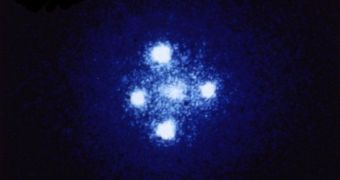The Einstein Cross or Q2237+030 is a gravitationally lensed quasar that, along with the lensing galaxy in front of it, creates a nearly perfect cross pattern, with the core of the galaxy in the middle flanked by four images of the quasar (see image). The lensed object is located at a distance of about 8 billion light years away from Earth, while the galaxy lies at a distance of about 400 million light years in front of the quasar.
A couple of years back, Sun Hong Rhie from the University of Notre Dame, US, decided to calculate just how many images of the background object a gravitational lens can create. The number is greatly influenced by the shape of the lens, therefore he started wondering how many images would create the gravitational lens of a small group of dense objects, such as stars and planets.
By arranging four stars in an equilateral triangle with one of the stars in the middle, Rhie discovered that up to 15 separate images of a galaxy could be created through the gravitational lens of the four stars and that for lenses of similar shape with 'n' stars as much as 5n-5 different images may be obtained. The problem was that there was no way to prove that.
Meanwhile, a team of mathematicians were working on a way to extend the fundamental theorem of algebra, governing the polynomial equations. According to the fundamental theorem of algebra a polynomial equation of degree 'n' has 'n' solutions.
"The fundamental theorem of algebra has been a true beacon, where modern algebra started", says Dmitry Khavinson from the University of South Florida.
Along with Genevra Neumann from the University of Northern Iowa, Khavinson tried to extend the theorem by studying rational harmonic functions, which involved the division of a polynomial equation by another. About four years ago, while working on the problem they discovered that one simple class of rational harmonic functions could never have a number of solutions greater than 5n-5, but they too were unable to prove that the found limit is also the true one.
Basically, they were trying to calculate the same thing as Rhie did, the positions of the images through a gravitational lens. By chance, Jeff Rabin from the University of California was familiar to Rhie's work and discovered that the pieces of information required to complete the mathematical calculations were found in her study.
Therefore, a gravitational lens on 'n' number of stars can create up to 5n-5 images of the lensed object.
"This kind of exchange of ideas between math and physics is important to both fields", said Rabin in an interview.
"I didn't even bother to submit my papers to journals because I had been so much harassed by the referees of earlier papers. I was new to gravitational lensing at that time. What I said and the way I said it must have been unfamiliar to the gravitational lensing experts", said Rhie.
Although her work was finally complete, there is no known application for it, because all the objects of the gravitational lens are placed in the same plane and are simple points. In the universe, gravitational lenses tend to be somehow less ordered, sometime consisting of several hundreds of galaxies occupying random positions in space which is most likely occupied by large quantities of gas and dust.

 14 DAY TRIAL //
14 DAY TRIAL //